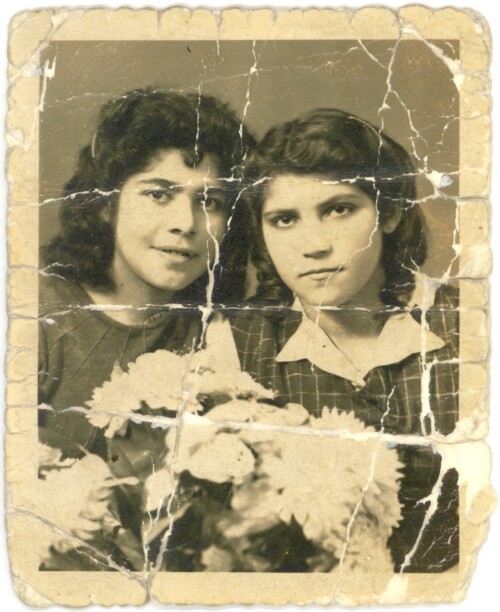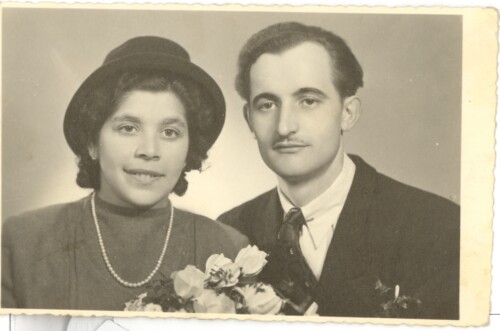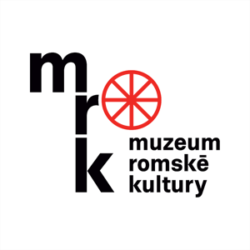

Josefa Štěpánková
Josefa Štěpánková, née Ištvánová, born 1925 in Lipník nad Bečvou, Přerov district
-
Testimony abstract
Before the war, Josefa Štěpánková’s family had a winter home in the municipal poorhouse in the village of Žďár,[1] while from spring to autumn they collected rags by horse-drawn cart around the villages. Her father then took these once a month to sell to the textile mill in Brno. Štěpánková reports that her father, whose name was Jiří Daniel, received as much as eight hundred crowns for the rags, which she says was good earnings for the first republic. They exchanged rags for stoneware, which they bought in Drnovice.[2] Her mother's name was Hedvika Ištvánová and all four children bore her name because the parents were not married. Josefa Štěpánková had older siblings, Jan and Anna, and a younger one, Jaroslava.
She says that after the arrival of Hitler[1] they were no longer allowed to make a living this way and had to settle in Žďár, where they lived in covered wagons. Her father broke stones, and her mother helped in households and in the fields. Josefa Štěpánková, who was fourteen at the time, worked for a local farmer.
In 1942, gendarmes from Sloup came in the middle of the night, forced them to pack only the bare necessities and took them to the so-called Gypsy Camp at Hodonín u Kunštátu. At that time, both older siblings were already living in Brno, but the gendarmes also took Josefa Štěpánková's aunt and her husband with Josefa’s parents and her sister Jaroslava. After arriving at the camp, they all had their hair cut off; the girls in particular mourned the loss of their hair. However, they were allowed to keep their civilian clothes. The conditions in the camp were not good; they were plagued by lice, lack of food, poor sanitation and infectious diseases. Josefa Štěpánková's mother died there of typhus and her father of dysentery.
Josefa Štěpánková recalled that once when she went to pick up lunch for her family, she was accused by Gendarme Vitouch[2] of having dirty dishes. She protested, so he beat her with a truncheon.[3] Josefa, who was fifteen or sixteen at the time, used to clean the gendarmes' quarters. When one of them started importuning her, she asked to be reassigned and then went to work on road construction in Makov.
She remembered a girl[4] who took care of the children when their mothers went to work, but cheated them and didn't give them their food rations, and then a doctor, Wyroba, in the sick bay,[5] who she said was “a good fellow”.
They spent thirteen months in Hodonín u Kunštátu, and then in August 1943 were assigned to a transport; they were told they would go to a better place. By that time, all who remained of the family were Josefa and her fourteen-year-old sister Jaroslava. They were taken to the border, she recalled, by a normal train and were accompanied by [Protectorate] gendarmes. They offered to let them escape, but Josefa and her sister had nowhere to go, so they stayed and reached Auschwitz where Germans with dogs were waiting for the prisoners.[6] They were taken from the train to the camp [Auschwitz II - Birkenau] in trucks. First they were tattooed with numbers and after a bath they were assigned different civilian clothes.
The two sisters spent the first weeks in quarantine, and after about six weeks they were assigned to the job of carrying stones from one place to another. Štěpánková said it was “work for work's sake”, and it was also very exhausting for both young girls. She said that she herself must have had a strong immunity, because she never contracted scarlet fever or whooping cough as a child from her siblings, and she also allegedly received an injection against typhus in the Hodonín camp. She considered herself lucky that she did not get sick, because those who did usually died, there was no medicine. Josefa’s sister Jaroslava succumbed to typhus, and her older siblings Jan and Anna had died in Auschwitz before the arrival of the two girls from Hodonín u Kunštátu.
Josefa spent eight months in the Auschwitz II - Birkenau concentration camp. When the Blockälteste offered the young female prisoners the opportunity to go to work in another camp, she had no one left and hoped that things would be better elsewhere. She signed up and took the transport[7] to what she called “Labesbrik”[8]. They were given grey prison clothes which they had to keep clean; the barracks were brick, and they even slept in sheets. They suffered from hunger, however, and were given only coffee for breakfast, boiled beets for lunch, and a slice of bread with margarine in the evening. At work, she and the other prisoners shovelled sand or unloaded briquettes from boats.
After a while, Josefa Štěpánková was sent to another concentration camp, which she considered horrible.[9] She worked in an underground factory making anti-tank rocket launchers, and although she fell ill and had fevers, she went on working. She did not want to be deported with the other sick people back to the camp [Auschwitz II - Birkenau], because she suspected that death would await her there.[10]
After three months she was transferred to Leipzig, where she worked among the civilian population. The conditions and atmosphere were better there; she and the other women prisoners even had occasional parties. After six months, she says, she was transferred to Taucha.[11] As the front approached, they were sent out on what was known as a death march: the prisoners were given bread and margarine, they were to take a blanket, a bowl and a spoon with them, and they went to an unknown destination. They would fall down from fatigue and hunger, but anyone who stopped was shot. After weeks of travel, in one village [the guards] sent her and three other women prisoners to the peasants for bread. When they returned, their transport was gone. They hid under the ruins of a destroyed bridge and after two days Russian soldiers took them in. They gave them tins of food. Josefa Štěpánková warned the women that they would be sick if they ate too much after weeks of starvation, and two of them did die.
- [1] That is, after the Protectorate was established in March 1939.
- [2] First name not given.
- About 35 gendarmes served in the camp, but only some of them have been named; Vitouch is not among them. (ed.)
- [4] Name not given.
- [5] Miroslav Wyroba only carried out supervisory duty at the hospital, he was not a doctor. Concerning him and Maria-Květoslava Ondrášová, see the memoirs of Hilda Laníková, née Ondrášová. (ed.)
- [6] Transport of 22 Aug. 1943. (ed.)
- [7] Transport of 15 April 1944. (ed.)
- [8] The Ravensbrück concentration camp.
- [9] According to confirmation from the International Nazi Persecution Centre in Bad Arolsen, Josefa Štěpánková was registered in sub-camps of the Buchenwald concentration camp, first from an unknown date in Schlieben and from 17 August 1944 in Altenburg. (ed.)
- [10] On 18 October 1944, 218 female prisoners were returned from the Buchenwald concentration camp to the Auschwitz II-Birkenau women's camp, including 49 Romani women from Altenburg and 168 Romani women from Taucha. (ed.)
- [11] She was held there from 7 September 1944 and in the local records was still there on 29 December 1944. (ed.)
After the war, the Russians took Josefa Štěpánková to Prague, whence she reached Brno. Almost no one in the family returned; only her cousin Pepík[1] and two uncles– “Růžička”[2] and Vincenc Daniel – survived. She said the latter escaped from Auschwitz[3] and hid in a dugout in Žebětín[4] until the end of the war.
How to cite abstract
Abstract of testimony from: NEČAS, Ctibor, ed. Nemůžeme zapomenout = Našťi bisteras : nucená táborová koncentrace ve vyprávěních romských pamětníků. Olomouc: Univerzita Palackého, 1994, 207-213. Testimonies of the Roma and Sinti. Project of the Prague Forum for Romani Histories, https://www.romatestimonies.com/testimony/josefa-stepankova (accessed 12/5/2025) -
Origin of Testimony
The tape recording and transcription of the recollection was made on 1 June 1986 by Ctibor Nečas, who preserved in the text the dialect spoken by the memoirist.
-
Where to find this testimony




